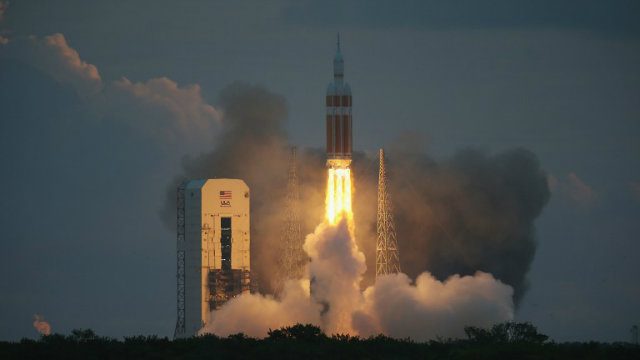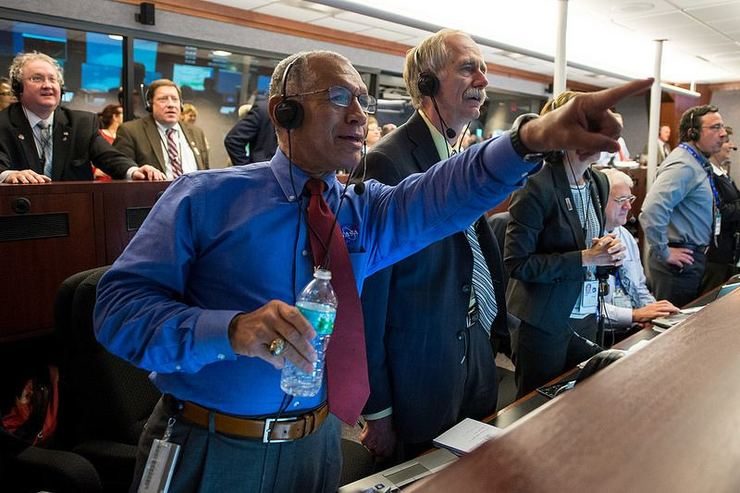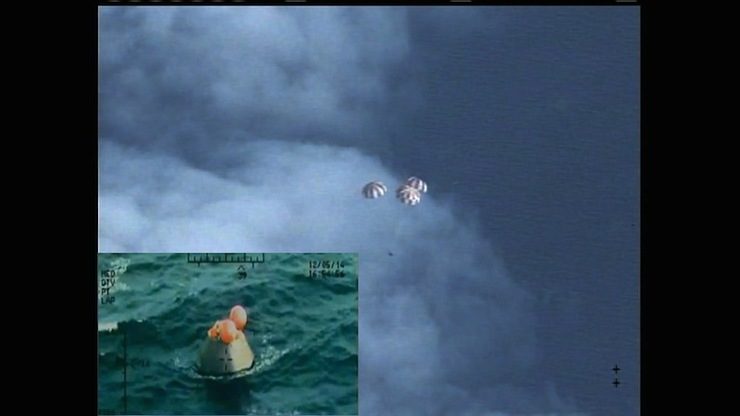SUMMARY
This is AI generated summarization, which may have errors. For context, always refer to the full article.

CAPE CANAVERAL, USA – A new US space capsule, Orion, circled the Earth twice before plunging into the ocean Friday, December 5, in a flawless test flight that opened a new chapter in human deep space travel.
The mission was the first in more than 4 decades of a new US spacecraft intended to carry humans to the Moon, an asteroid, or Mars.
“We as a species are meant to push human presence into the solar system, and this is a first step,” said NASA associate administrator for human exploration, Bill Gerstenmaier.
The unmanned vessel soared into space at 7:05 am (1205 GMT, 8:05 pm in Manila) atop a United Launch Alliance Delta IV Heavy rocket that rumbled and roared as it climbed into the pastel skies over the Florida coast at sunrise, leaving a plume of smoke in its wake.
“It was just a blast to see how well the rocket did,” said Orion program manager Mark Geyer, after technical issues with the rocket and wind gusts delayed the first launch attempt Thursday, December 4.
“We really pushed Orion as much as we could to give us real data that we can use to improve Orion’s design going forward.”
The four-and-a-half hour flight was “picture-perfect” and “a significant milestone for America’s space program,” said NASA commentator Rob Navias.
“There is your new spacecraft, America,” he said as live aerial images showed the capsule floating toward the Pacific Ocean aided by three parachutes.
NASA engineers will carefully study the data it collected — particularly regarding the performance of the heat shield — in the days and weeks to come to see how the capsule withstood the stress of space flight.
Live video images from the spacecraft showed stunningly high views of Earth as well as the capsule’s dramatic return to the Pacific Ocean.
A trio of NASA astronauts watched on large televisions at Kennedy Space Center and bumped fists when Orion splashed down, as the packed press room erupted in cheers.
“We have kind of turned a corner from the post shuttle period and it is nice to see the new vehicle up in space,” said astronaut Rex Walheim, still grinning after the successful test.
“It has got a lot of pieces of the puzzle to go yet but we are making tremendous progress,” he told Agence France-Presse.

The United States has been unable to send astronauts to the International Space Station since the shuttle program ended in 2011 after three decades, leaving no option but to pay Russia to carry astronauts on its Soyuz capsules at a cost of $71 million per seat.
Peak height
The spacecraft made two loops around the Earth, first orbiting about as high as the International Space Station, which circles at an altitude of about 270 miles (430 kilometers).
Then, a second stage engine burn propelled the spacecraft higher than any vessel meant to carry people since the Apollo 17 moon mission in 1972.
About 3 hours into the flight, at 10:11 am (1511 GMT, 11:11 pm in Manila), the spacecraft reached its peak height of 3,604 miles above the Earth.
Four hours 24 minutes after launch, the spacecraft plunged into the waters off California to be retrieved by the US Navy.

An analysis of sophisticated sensors on the capsule should let NASA know how the heat shield performed and if the temperature inside remained survivable for a potential crew.
The spacecraft’s exterior heated to 4,000ºF (2,200ºC) during its re-entry to Earth’s atmosphere at a velocity of 20,000 miles per hour.
Future missions
Potential future missions for Orion, which can fit four people at a time, include a trip to lasso an asteroid and a journey to Mars by the 2030s.
“It’s a big day for the world, for people who know and love space,” NASA administrator Charles Bolden said.
NASA has already spent $9.1 billion on Orion and the powerful rocket meant to propel it with crew on board, the Space Launch System (SLS).
Another unmanned test flight is slated for 2018. The first Orion test flight with a crew on board is scheduled for 2021, when total costs are projected to reach $19 to $22 billion. – Rappler.com
Add a comment
How does this make you feel?
There are no comments yet. Add your comment to start the conversation.